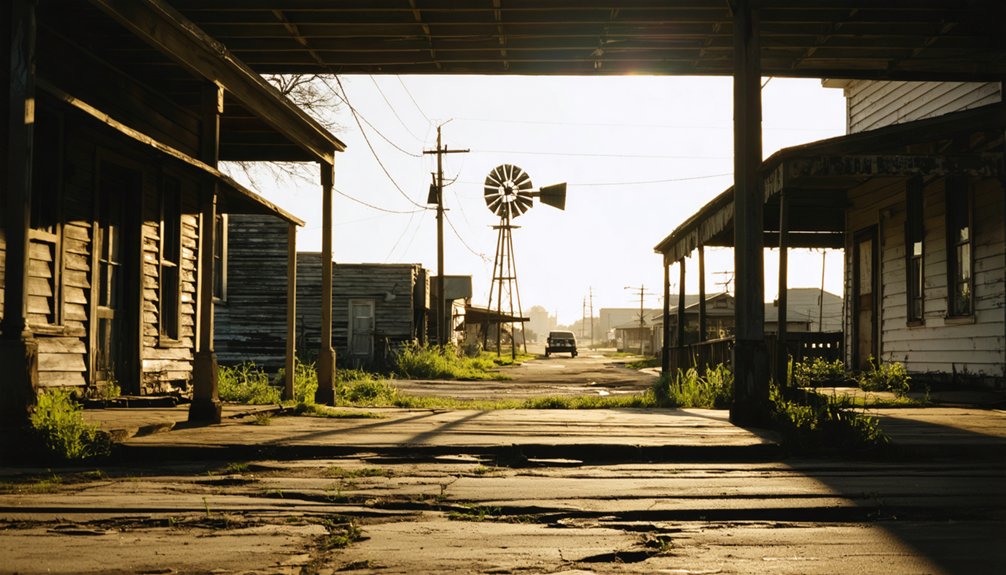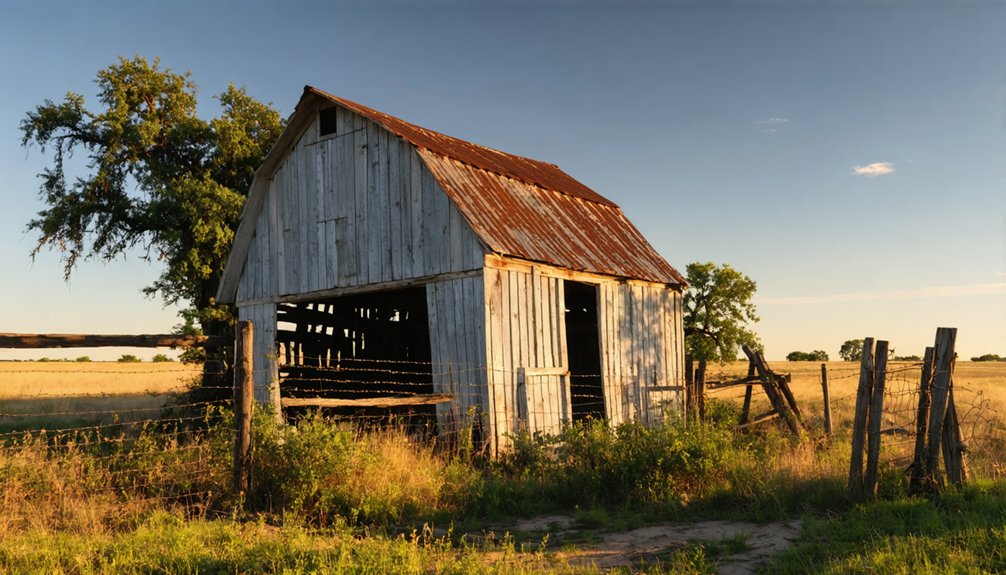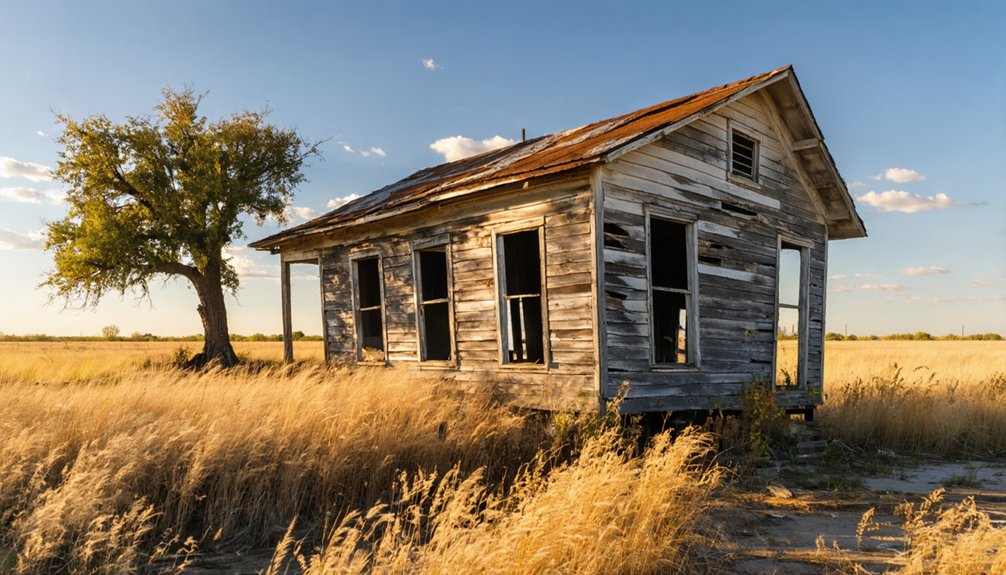You’ll find Illinois Bend in Montague County, Texas, where frontier settlers from Illinois established a thriving community in 1862. Originally called Wardville, then Maxwell, the town peaked at 300 residents in the 1880s with a post office, general store, and Masonic Lodge. The community faced Comanche raids, severe weather, and devastating floods before declining after being bypassed by the railroad. Today, this ghost town‘s remnants tell a compelling story of frontier resilience and untamed wilderness.
Key Takeaways
- Illinois Bend was established in 1862 as a frontier settlement in Texas, reaching its peak population of 300 residents in the 1880s.
- The town featured Fort Illinois Bend, a post office, general stores, and a schoolhouse that served 125 students by 1918.
- Economic decline began when the railroad bypassed the town, reducing population to 112 by 1910.
- The post office’s closure in 1930 marked a significant turning point in the town’s abandonment.
- Today, Illinois Bend stands as a ghost town, preserving the legacy of Texas frontier life and 19th-century settlement struggles.
The Early Days of Settlement
The frontier spirit of Illinois Bend emerged in 1862 when settlers from Illinois established a new community along a strategic bend in the Red River.
You’ll find its early history marked by settler struggles, as the town underwent several name changes – from Wardville to Maxwell, and finally to Illinois Bend in 1877 when its post office opened.
The frontier challenges these pioneers faced were intense. They’d built Fort Illinois Bend about 1.5 miles southeast of the settlement for protection, as they confronted daily threats from wildlife and severe weather. The community was originally called Wardville after Ward, the primary landowner who helped establish the settlement.
The isolation meant you’d have to travel miles for basic supplies like flour and ammunition. Despite these hardships, the community grew, though only the most resilient stayed. Many others returned east, unable to withstand the harsh realities of frontier life. A local militia formed to protect settlers from frequent Indian raids in the area.
Life in a Texas Frontier Town
You’d find the daily rhythms of Illinois Bend centered around essential farming and ranching tasks, with settlers tending to livestock, working fertile soil, and preserving food stores for winter months.
The town’s modest wooden church and one-room schoolhouse served as crucial community anchors, where families gathered for Sunday services and children received basic education with limited resources. Living history demonstrations help modern visitors understand these frontier education experiences.
Trading posts and local markets buzzed with activity during gatherings, where settlers exchanged goods, shared news, and maintained social bonds despite the harsh realities of frontier isolation. The area’s wild longhorn cattle roamed freely through the valley, providing both opportunities and challenges for early settlers.
Daily Rural Settlement Routines
Living in Illinois Bend meant adhering to strict daily routines shaped by agricultural demands and frontier survival needs. You’d start your day before sunrise, tending to livestock that needed feeding and watering. Daily chores included maintaining fences, repairing equipment, and watching for threats to your property.
Women managed the household’s survival through cooking, cleaning, and preserving food, while children helped with gathering water and firewood. Life wasn’t too different from that of frontier settlers who traveled along the Chisholm Trail to establish new homesteads. Social gatherings were rare but treasured events that brought relief from the isolation of frontier life.
Seasonal tasks dictated your work rhythm – spring meant plowing and planting, summer brought constant crop maintenance, fall demanded intensive harvesting, and winter focused on repairs and food preservation.
You’d trade with neighbors at local markets, often bartering goods since cash was scarce. Every day required vigilance against fires, outlaws, and weather threats, making community cooperation essential for survival.
Church and School Life
Settlers in Illinois Bend initially gathered for worship services in private homes, lacking dedicated church buildings in the community’s early days.
By 1885, you’d find multiple faith traditions represented, with services later moving to the local Masonic Lodge.
The community’s educational practices centered around a wooden schoolhouse built in 1893, where the lower floor served both classroom and church functions while Masons met upstairs.
You’d see the school thriving by 1918, with three teachers instructing 125 students in reading, writing, and arithmetic.
The building became a crucial hub where you could attend community gatherings, social events, and religious services.
The area’s fertile river bottom made it attractive for early settlers seeking agricultural opportunities.
The town’s original name of Wardville came from local landowner C. M. Ward before changing to Illinois Bend in 1877.
Even as the town’s population declined after 1910, these institutions remained steadfast pillars of frontier life, preserving both educational standards and spiritual values.
Trade and Social Gatherings
Beyond the classroom and church walls, Illinois Bend’s commercial heart beat strongly through its network of businesses and social spaces. You’d find the town’s social networks thriving at general stores, where locals gathered to exchange news and conduct business.
The stores followed a model like those in Spanish colonial towns, where ranchers and merchants traded goods and shared information about the latest market conditions. By the 1880s, you could visit three general stores, two grist mills, a cotton gin, drug store, and barber shop. Trade events centered around cotton production, with tenant farmers bringing their harvests to local gins for processing. The community reached its peak of 300 residents during this bustling period.
Masten’s “Cottage Hotel” welcomed traveling salesmen, while the blacksmith shop buzzed with farmers maintaining their equipment. The post office, operating from Grigsby’s store since 1875, connected residents to the outside world.
Though the railroad’s bypass eventually stunted growth, Illinois Bend’s early commercial importance shaped its frontier identity.
Economic Rise and Development
During its early development in the 1860s and 1870s, Illinois Bend emerged as a thriving agricultural hub centered around grain and cotton processing. You’d have found a bustling community where two gristmills and multiple cotton gins drove the local economy, showcasing early attempts at economic diversification.
The town’s agricultural advancements supported a growing population that reached 300 residents by the 1880s. The settlement’s prosperity attracted farmers and entrepreneurs who established essential services, including several churches that formed the backbone of community life.
While the economy remained primarily focused on manual agricultural processing, the infrastructure you’d have encountered included local farms producing cash crops. This economic foundation created jobs and sustained the town’s growth throughout its peak years.
Community and Daily Living

During Illinois Bend’s peak in the 1880s, you’d find the community gathering regularly at several churches and the local schoolhouse, which served as essential social hubs beyond their primary functions.
Your daily routines would’ve revolved around the agricultural calendar, with farmers working the cotton fields and bringing their harvests to the local gristmills and cotton gins.
If you’d visited the post office between 1877 and 1930, you’d have encountered neighbors exchanging news and conducting business, making it a central feature of community life alongside the Illinois Bend Cemetery, where generations of families maintained their connections to the settlement’s earliest days.
Social Gathering Places
While Illinois Bend‘s remote frontier location posed challenges, the settlement maintained vibrant social spaces that served as the lifeblood of community interaction.
You’d find social centers scattered throughout the settlement, from the protective Fort Illinois Bend to the bustling general stores and saloons where residents exchanged news and conducted business. The post office, when operational, became a vital hub for communication and trade.
Community gatherings often took place in ranch houses and cotton farmsteads, where neighbors provided mutual support and shared resources. Local saloons weren’t just drinking establishments – they hosted significant business dealings, celebrations, and served as indoor meeting spaces.
Even the school and church buildings doubled as venues for town meetings and social events, strengthening the bonds between isolated frontier families.
Daily Routines and Traditions
Life in Illinois Bend revolved around survival-focused daily routines shaped by frontier challenges. You’d start your day early, maintaining constant vigilance against Comanche raids and dangerous wildlife while tending to essential farming and ranching tasks.
Family traditions centered around mutual protection, with members taking shifts for night watches and coordinating defensive strategies with neighbors.
Your daily activities included processing crops at local gristmills, managing livestock despite predator threats, and making long supply runs for necessities.
While seasonal celebrations occurred at the schoolhouse, they’d often be planned around safety concerns. Women upheld traditional roles but showed remarkable adaptability during emergencies, like Mrs. Willett’s barefoot journey for help.
You’d “fort up” when needed, joining other families in communal defense efforts that became an integral part of Illinois Bend’s social fabric.
The Path to Abandonment
Despite its promising beginnings in 1862, Illinois Bend’s path to abandonment took shape through a perfect storm of challenges that gradually eroded its viability as a settlement.
You’d have witnessed the early settlement hardships as pioneers faced relentless Comanche and Kiowa raids, forcing them to “fort up” for survival.
Environmental challenges struck hard – the Red River’s devastating floods, including the 40-foot surge of 1891, repeatedly destroyed crops and property.
When railroads bypassed the town, you would’ve seen its population plummet from 300 to just 112 by 1910.
The closure of the post office in 1930 signaled the town’s terminal decline.
Agricultural shifts from cotton to ranching, coupled with inadequate infrastructure and ongoing natural disasters, sealed Illinois Bend’s fate, leaving only 40 residents by 2020.
What Remains Today

Today’s Illinois Bend bears little resemblance to the once-thriving frontier settlement it used to be.
You’ll find few remaining structures at the site, with most buildings having succumbed to time and neglect. Nature has largely reclaimed the land, transforming the former townsite into open pastures and brushland typical of rural North Texas.
If you’re hoping to explore the ghost town, you won’t find any formal tourism infrastructure or historical markers to guide your way.
The site is accessible mainly by unpaved rural roads, and you might spot scattered rubble or foundation remnants among the vegetation.
While historical records exist in county archives, physical evidence at Illinois Bend is sparse, limited to occasional artifacts that remind visitors of its frontier past.
Historical Legacy and Significance
Illinois Bend stands as a compelling representation of Texas frontier life, embodying the quintessential struggles and triumphs of 19th-century settlement.
You’ll find its cultural heritage deeply rooted in the migration patterns of Midwestern families who bravely ventured from Illinois to establish a new life along the Red River. The settlement’s story mirrors the broader American frontier experience – marked by conflicts with Native Americans, isolation, and the raw determination required to survive.
Through waves of migration and hardship, Illinois settlers carved out a new existence on Texas’s unforgiving frontier.
What makes Illinois Bend particularly significant is how it adapted through time, evolving from cotton fields to ranch lands while preserving its frontier character.
Though now a ghost town, it’s left an indelible mark on Montague County’s history, serving as a tribute to the resilience of early Texas settlers who faced overwhelming odds to build lasting communities.
Frequently Asked Questions
Are There Any Ghost Stories or Paranormal Reports From Illinois Bend?
You won’t find many documented local legends from Illinois Bend, though violent frontier conflicts and settler deaths could’ve spawned haunted locations – they’re just not well-recorded in public archives.
Can Visitors Legally Explore the Remains of Illinois Bend Today?
You’ll need landowner permission to explore most Illinois Bend remains, as visitor access is restricted by private property laws. The cemetery and visible structures from public roads are legally accessible.
What Natural Disasters or Extreme Weather Events Affected Illinois Bend?
You’ll find records of major flood events and tornado activity that struck this area, particularly during the devastating 2019 floods that damaged local infrastructure and the recurring severe storms common to Texas’ climate.
Were Any Famous Historical Figures Known to Visit Illinois Bend?
You won’t find any famous visitors in Illinois Bend’s records. While brave frontier families carved out their existence, the settlement’s historical significance centered on survival rather than hosting distinguished guests or dignitaries.
Did Illinois Bend Have Connections to Native American Settlements Before Establishment?
You’ll find that Native American tribes, particularly Comanche and Kiowa, actively inhabited and raided this area along historical trade routes before settlers arrived, using the land for hunting and seasonal movements.
References
- https://www.islands.com/1914329/terlingua-ghost-town-buried-texas-chisos-mountains-big-bend-region-haunting-abandoned-vibrant-art-community/
- https://texashighways.com/culture/history/chasing-quicksilver-mercury-mining-history-in-beautiful-big-bend/
- https://www.explore.com/1815119/just-outside-big-bend-national-park-lies-eerie-underrated-texas-ghost-town-terlingua/
- https://www.youtube.com/watch?v=UniG4FbRwaw
- https://bigbendguide.com/raiders-of-the-lost-park-the-ruins-of-big-bend/
- https://authentictexas.com/texas-ghost-towns/
- https://en.wikipedia.org/wiki/List_of_ghost_towns_in_Texas
- https://www.texasescapes.com/CentralTexasTownsNorth/Red-River-Station-Texas.htm
- https://en.wikipedia.org/wiki/Illinois_Bend
- https://stonewallsaloonmuseum.com/local-history



